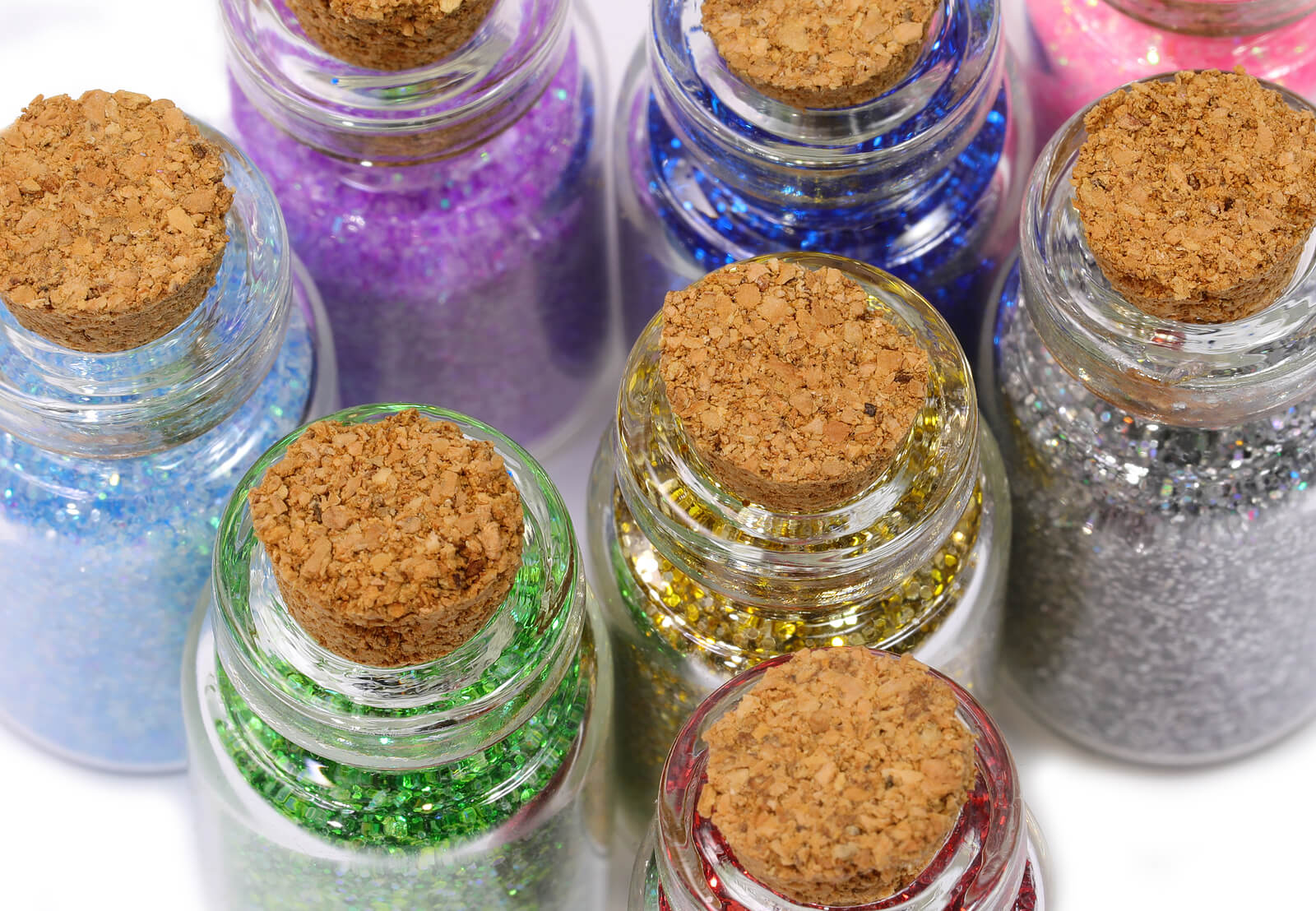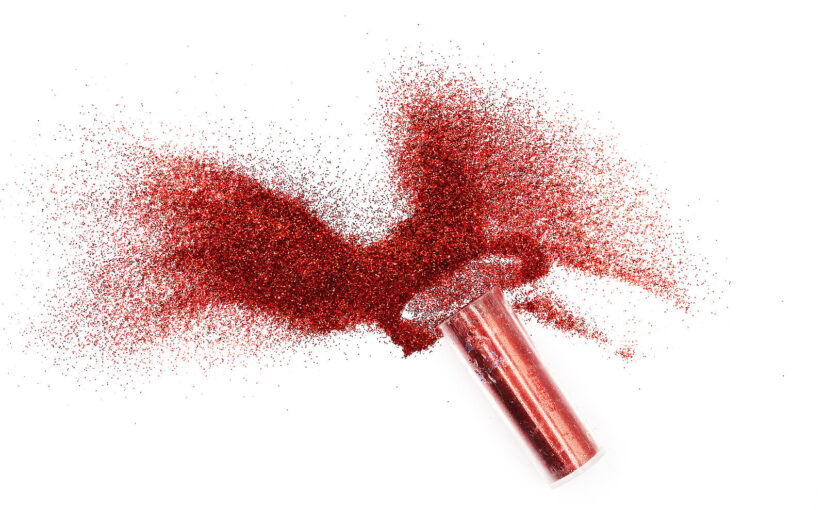Glitter is attractively sparkly and adds a touch of magic to many corners of our lives — from fashion and greetings cards to festivals and crafting.
While it’s undeniably pretty, glitter’s impact on the environment has become a hot topic in the broader conversation on sustainability.
Let’s shine a spotlight on glitter and see how this snazzy product has become a glaringly obvious problem for the planet.
What is glitter?
Humans first purposely created glittery substances between 50,000 and 12,000 years ago.
During the Upper Paleolithic period, shiny flakes of mica rocks were used as glitter in cave paintings. Interestingly, mica is now used in the cosmetics industry to create shimmery eye and lip products.
By the 14th century, ancient Egyptians commonly used crushed-up beetles and ground green malachite crystal to add glimmer to their cosmetics. Cleopatra made her trademark shimmery lipstick by mixing crushed carmine beetles, red ants, fish scales, flowers, beeswax, and berry juice for the perfect rouge pout.
Glitter, as we know it in the 21st century, was invented in the 1930s by an American farmer named Henry Ruschmann. He set up Meadowbrook Inventions, which is still one of the leading global suppliers of glitter today.
Modern glitter consists of small reflective particles sold in various colours, shapes, and sizes.
Common glitter shapes include hexagons, hearts, squares, stars, and circles, and particle sizes range from 0.05mm up to 6.25mm per particle.
Glitter is usually manufactured from polyvinyl chloride (PVC) and polyethylene terephthalate (PET), covered in a thin layer of aluminium to add colour and sparkle. Sometimes styrene acrylate is added, too.
The final product is an appealing and highly recognisable decoration used across countless industries.
Why is glitter bad for the environment?
PVC, PET, and styrene acrylate are all plastics, and aluminium is a metal.
Unlike, for example, a plastic bottle, the size of glitter particles makes them microplastics before they’ve even degraded.
Microplastics are a significant source of ocean, air, and soil pollution. Due to their size, they often find their way into animal and human bodies, making them a threat to health.
Marine life struggles to distinguish between food and plastic. As a result, fish, marine mammals, and birds regularly consume microplastics, which can cause digestive blockages that can result in death.
Through the water and beer we drink and the seafood and salt we eat, it’s thought that every human consumes around a credit card’s worth of plastic per week — which equates to 250g per year.
With research suggesting plastics can cause wide-ranging health issues in humans, including cancer and congenital disabilities, this shocking rate of plastic consumption isn’t welcome news.
Plastic glitter isn’t biodegradable and takes so long to degrade in the environment that all the glitter ever made still exists. Most can be found in the ocean, having made its way there via wastewater and landfill run-off.
Plastic is manufactured from hydrocarbons which are derived from fossil fuels. Therefore, glitter contributes to the climate crisis from the moment it’s produced.
While glitter is tiny and easy to dismiss, it’s a common product and a critical factor in the bigger picture regarding the relationship between plastic and the environment.
In 2018, 61 British music festivals banned the sale of glitter, citing environmental concerns, and a handful of British retailers chose only to sell glitter-free Christmas cards and gift wraps in 2020.
Glitter as evidence in a murder case
Glitter is notoriously tricky to clean up because it is tiny and static, so people often find it for months or even years after use.
The characteristic that frustrates parents and teachers most is why a forensic scientist was able to use glitter to solve a murder case in California, USA.
Now retired, Ed Jones was a forensic scientist at Ventura Sheriff’s crime laboratory. In 2001, he solved a murder by matching glitter found on a victim’s scalp to that found in the suspect’s vehicle.
The suspect had cleaned the vehicle after committing the crime, but the glitter was, unsurprisingly, still present, enabling the suspect to be charged with murder.
Alternatives to glitter

Since consumers started to pay attention to how their purchases impact the environment, the market has been flooded with glitter alternatives, all claiming to be kinder to the planet.
The best way to reduce your contribution to microplastic pollution is to avoid glitter altogether. Still, we understand that’s not always possible, and not everyone is ready to give it up.
Let’s see what the alternatives have to offer.
What is eco-glitter?
You’ve probably heard of eco-glitter, but what is it?
Eco-friendly glitter is now widely available, but Bioglitter is the only certified biodegradable manufacturer in the UK. Even better, their PURE range is 100% plastic-free. None of the brand’s products are vegan or vegetarian, because they use shellac (a resin made of insects) as a primary ingredient.
Meadowbrook Inventions, the company that first manufactured glitter, also stocks biodegradable options in the USA.
Eco glitter is glitter made from earth-friendly ingredients. But is biodegradable glitter kinder to the environment than standard glitter?
Scientists from the Anglia Ruskin University (ARU) in Cambridge have unfortunately found that some ‘environmentally-friendly’ glitters are still detrimental to the environment and damaging to rivers and lakes. This is because they are coated with alumimium and, sometimes, plastic, which almost defeats the point of referring to them as eco-friendly.
Do your research before you make your purchase, and choose wisely.
What is edible glitter?
There are two types of glitter sold for cake decoration, and they differ significantly.
Edible glitter is a sparkly confection made from starch that’s safe to eat and fully digestible. Non-toxic or “food contact” glitter isn’t edible and typically contains plastic.
Edible glitter has no more impact on the environment than other foods. Non-toxic glitter, however, has the same impact as standard plastic glitter and is best avoided.
The future of eco-glitter
Waste glass could be a sustainable alternative to plastic glitter, but unfortunately, it would be unsafe for most applications.
Scientists from the University of Cambridge invented an eco-friendly glitter alternative inspired by nature. It is made purely from cellulose — a material found in the cell walls of fruit, vegetables, and plants.
This product is fully sustainable, biodegradable, non-toxic, and vegan. It will also never lose its sparkle — unlike standard plastic glitter.
Now you’ve learnt more about the eco credentials of glitter, dive into our guides on eco-friendly gift giving and recycled gift wrap.
